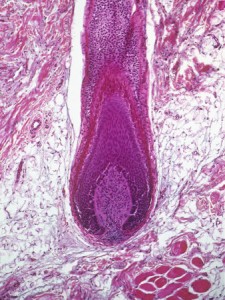Scarring is a big issue for plastic surgeons. There is no such thing as scarless surgery… yet. We do pretty scars, hairline scars. We hide them. I have had some scars where I can’t find it, even when I am an inch away. So why do some scars heal better than others?
I have talked in previous blogs about the big 3 issues for scar: genetics, tension, and inflammation. So what do sweat glands and hair follicles have to do with anything?
Keratin. Turns out keratin, which is found in the outer layer of your skin and the lining of the sweat glands and hair follicles is really irritating. Keratin causes inflammation, which we know from the big 3 above, is one of the things to avoid to get pretty scars.
This is simple, but insightful for us plastic surgeons. I know from almost 20 years of being a surgeon that certain areas of the body almost always tend to heal well. Example: eyelid. I don’t know I have ever seen a keloid or hypertrophic scar there.
Other areas tend to heal poorly… Example: sternotomy or Csection wound. But in these areas I see variability. Some people heal well, and others don’t. Why? Is it tension? Genetics? That is always what I chalked it up to. But perhaps it isn’t. Perhaps it has to do with how oily is their skin? Do they have more sweat glands? Did the incision go within the hair for their C section (so in the midst of hair follicles)? Or at the top of the hair border?
Also I know from practice that people with thin, fair skin tend to heal better than those with thicker, more oily sebaceous skin. Again, we could chalk it up to genetics, but maybe it isn’t. Maybe it is the thin skinned patients who have that “dry” skin may have less glands, so they have less keratin irritating the scars as they heal.
They did an experiment: They looked at C-section scars. In those which formed bad scars they found a lot of inflammation. Many also had ingrown hairs. So they thought to reduce the hair follicles. They did laser hair removal, cut out the bad scar, and reclosed. Result: better scars. The rationale was they reduced the keratin by damaging the hair follicle. (Laser hair removal works by targeting the melanin pigment in the hair, heating it up to cause scarring of the follicle and preventing regrowth.)

Simple thing, not revolutionary. But this simple premise of glandular and hairy tissue leading to poorer scars is one we see in practice. This may mean if we can do things to minimize them (?laser hair removal, ?try to make incisions outside of the hair bearing area ? other ideas) we may be able to improve scars.
